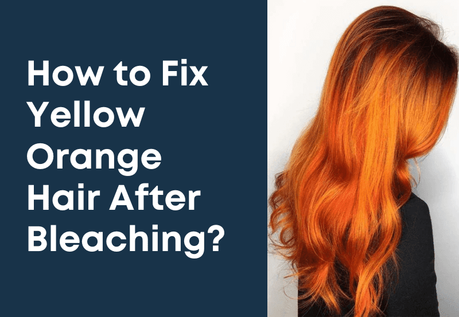For millennials, experimenting with various hair colours has become a passion. People with different lengths and hues of hair are constantly eager to switch up their hair color according to the season. Choosing the appropriate hair color has always been important to many individuals. Yet we are oftentimes met with incidents that leave our hair with undesirable results. And let us tell you, most of these colouring incidents have involved people who had no prior information.
Fixing Yellow-Orange Hair After Bleaching
But hold on, folks! Don't worry; it's not as bad as you think. There are ways to restore the color of your bleached orange hair. While orange is a lovely and vibrant colour, not everyone prefers orange hair, and errors in hair color are never fun. We'll talk about the numerous reasons why your hair ended up the color you didn't expect. And what you can do to stop it from occurring again.
What exactly is Yellow-Orange Hair?
Brassy hair is another term for orange hair. You'll notice a combination of rosy and yellowish tones or either the red or yellow tones separately. Typically, half a month after getting your hair coloured, you may see this brassiness on it. It could take place if a woman with dark hair gets her hair coloured lighter.
Don't worry; you can tone orange hair after bleaching, so you won't have to leave with brassiness in your hair.

The Causes of Yellow-Orange Hair:
Let's investigate what makes bleached hair become orange. Even better, you'll be able to understand why it turned out to be incorrect and attempt to avoid doing anything that may turn it orange in the future. Let's go over the potential causes of your hair turning orange now.
Bleaching has an effect on natural pigment.There is a reason why bleaching your hair can cause you to look brassy and unprofessional. The use of several dangerous chemicals during the bleaching process breaks down the nutrients in your hair and has negative consequences. Unbelievably, your regular hair colour, which contains bleach, is to blame for making you brassy, not your hair.
Permanent dye is the second cause.It is a major contributing factor to the brassiness of your hair. After a few washes, you may notice that the color of your hair changes and becomes brassy. One explanation for it may be permanent hair colouring.
When everything is said and done, the concept of permanent hair color is to remove the initial shade of your current hair color even before you decide to apply it with artificial hair dye.
Environmental factors are a cause too.Your hair may also become yellow-orange due to environmental causes, including pollution and smoking.
Water also contributes to brassy hair since it has a lot of mineral substances that can build up in your hair and damage it. Using a water RO system, which may reduce the quantity of dangerous compounds that have the potential to reach your locks, is an easy way to solve this problem.
The use of sulfate-based shampoosBased on its unique characteristics, each hair requires particular maintenance. The precautions that must be taken before using this shampoo may not be known to many people. Most often, victims of such crimes are those with light hair.
Knowing this, you should be careful with the product you use since it could cause your hair to become orange after bleaching. For instance, using sulphate shampoos on light hair may cause it to become yellow, orange, or bold.
Natural hair color that does not mix well with synthetic hair color.For instance, when dying natural hair, pink and white must be combined to achieve a red hue. That is very similar to the concept of combining colours. If you mix pink hair dye with another colour, you will obtain a new tint. Additionally, it relates to hair color.
It is brassy when the color of your hair does not complement your skin tone.
Techniques for Restoring Hair After BleachingNatural remedies will simultaneously nourish your strands while treating your yellow or orange hair. You may pump and style your orange hair with its aid.
Using Baking Soda and Lemon JuiceUsing lemon juice and baking soda is another highly effective technique. Let's say you want to reduce the amount of brassiness on your scalp. Then, as both lemon juice and baking soda are bleaching agents, you should use them together to achieve your goals.
Coconut Oil and SaltYour hair color can be protected with coconut oil. Additionally, salt can neutralise the orange color that results from bleaching. Blending is more effective since the two elements work well together. It becomes one of the most effective strategies you try.
Using apple vinegar and ciderVinegar made from apple juice aids in eradicating the orange effect on your scalp. Since vinegar does not encourage you to get rid of frizz, you must use it to remove bright orange hair.
Your hair will seem more spectacular and will be smoother as a result. Not only does it make your hair smoother, but it also aids in preserving the health of your hair and regulating the pH levels throughout your head. It's possible that the cider and vinegar will give your hair a small earthy tint, but don't worry—it will likely wash out eventually on its own.
Using tea bagsBrassiness in your hair is effectively removed and diminished by teabags. When controlling the orange impact on your scalp, it would be great if you made sure to get the most out of this therapy.
The final word
As we went through several suggestions and guidelines on how to cure brassy hair and get rid of the brassiness, pick the approach that feels the most authentic to you. There are several methods for treating brassiness in various hair types. The best person to answer this question about your own hair type is you.
